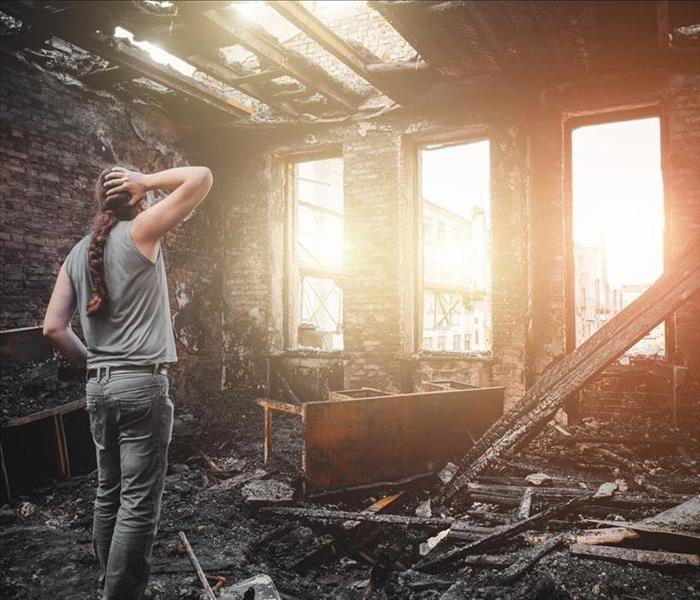Fire Damage Restoration Process
5/6/2021 (Permalink)
 There are many hazards that come with the aftermath of a fire. You should wait for an inspector to deem the property safe before you enter.
There are many hazards that come with the aftermath of a fire. You should wait for an inspector to deem the property safe before you enter.
The Fire Damage Restoration Process
Few events can prove more detrimental to a property or its owners than fire. Fortunately, such occurrences do not necessarily have to spell the end of said structures. However, favorable outcomes in the wake of these events often necessitate the aggressive intervention of a fire restoration company like SERVPRO.
Salvaging a residential or commercial property following a fire requires adherence to strict guidelines such as:
Ensuring The Property Is Secured
Fire-damaged properties often possess several notable safety hazards.
First, these locations could still be precariously warm. The smoldering ashes and soot enveloping various internal components can still be too hot for persons to safely spend extended time periods and might precipitate potentially serious health effects.
Additionally, fire can create unsafe air. Oftentimes, infernos send a host of contaminants and pollutants into the surrounding air. Inhalation of these particles could result in short and long-term health effects.
Furthermore, the fire-destructed property could prove structurally unsafe. Structural instability could result in injury-inducing, potentially fatal events like building collapses.
Therefore, structural engineers and other safety experts must examine the fouled construction and ensure it is safe enough to spend any appreciable amount of time inside.
Performing A Thorough Assessment
Once the structure in question is secure, a team of experienced fire restoration professionals can enter the said property and perform a comprehensive evaluation. These trained subjects will determine the percentage of the structure that sustained fire damage, in addition to the severity of said destruction.
These findings will enable the investigating team to opine what remediation needs to be executed and the most befitting way to complete the said process.
Minimizing The Overall Damage As Much As Possible
The extent of the fire event often dictates if any personal property or the structure's interior components can be salvaged. However, following minor to moderate events, homeowners might be able to save certain property or heirlooms. Said holdings should be taken out of the damaged construction as soon as possible.
Beginning The Cleaning Process
As soon as the appropriate authorities deem the structure secure, the cleansing stage should commence.
Fire damage often leaves a significant number of large messes to clean, including soot, ash, and an appreciable accumulation of water used to douse said flames.
Many fire restoration specialists will reiterate the potential hazards contained in fire byproducts like soot and ashes. That said, water contamination can be just as if not more harmful to the property left intact, those executing the cleanup efforts, and the residents, employees, or patrons returning to the soon-to-be restored residential or commercial construction.
Small quantities of water are more than enough to cause extensive damage to interior features, such as walls, ceilings, various types of flooring, and furniture upholstery.
Moreover, water can quickly spurn the growth of illness-inducing substances like mildew and mold. These materials are known to precipitate appreciable health effects in sensitive individuals.
Ergo, these materials must be removed as quickly as possible by those holding the experience to complete said task properly. Furthermore, even the most minor fires will leave a trail of smoke, stains, and foul odors behind.
Eradicating these problematic occurrences often necessitates intense and comprehensive cleansing using products and implements specifically designed to tackle such jobs. Additionally, water removal may require specialized fans, dehumidifiers, and heaters. Furthermore, thorough remediation of carpeting and upholstery might be indicated to remove bothersome odors.
Restoration
Restoration is the process's final stage. The extent of this undertaking will depend heavily on the fire's severity and the type of material damaged as a result.
Typically, paint is a common fire casualty. This aesthetic wall covering often develops discernible bubbling and blistering following said events. Such damage must be scraped clean and thoroughly repainted.
Moreover, there is no one universal method for remediating, repairing, or replacing damaged materials like wood. Every building product falls under its own set of therapeutic protocols that must be carefully followed.
Skilled restoration contractors will possess this experience and know the proper remediation techniques to employ.
Contacting SERVPRO
Fires are often devastating events. However, residential and commercial property owners can recover from them. That said, they must act quickly and entrust an experienced restoration company like SERVPRO to handle the delicate but crucial steps needed to complete the restoration process.




 24/7 Emergency Service
24/7 Emergency Service